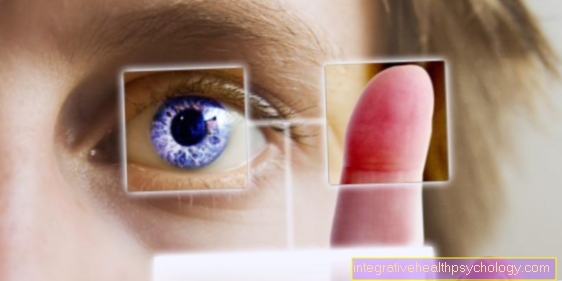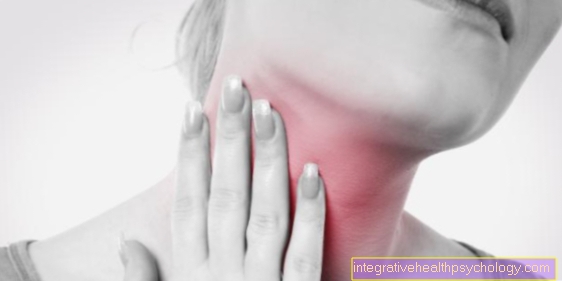Depilatory cream
definition
Depilatory creams are based on a chemical method of removing body hair. Hair removal using depilatory cream is a depilation process. This means that only the part of the hair that is visibly outside the skin is removed. This means that the application of depilatory cream is painless, but the hair grows back relatively quickly. There are various preparations on the market that can be used on different parts of the body. Areas of the body that are often treated with depilatory cream are, for example, the legs, armpits, chest or the genital area.
You can find out more about depilation in general here: Depilation - The different options.

What do you need depilatory creams for?
Depilatory cream is used to remove body hair from various parts of the body and is therefore an alternative to shaving. In line with today's ideal of beauty, many women want thorough hair removal, especially of the legs, armpits and genital areas. The removal of body hair (especially on the chest, back and armpits, as well as in the genital area) is also enjoying increasing popularity among men. Depilatory cream can be used here in a similar way to classic shaving by painlessly removing the visible parts of the hair. This is where it differs from depilatory methods such as epilation or waxing. The entire hair including the roots is removed, so that the application is perceived as painful.
How does a depilatory cream work?
Depilatory cream is an agent that can be used to chemically remove body hair. Preparations are available in the form of creams, lotions or in the form of foam products that can be purchased in the drugstore. These are applied to the part of the body to be depilated (e.g. legs) and, depending on the product, left on the skin for a few minutes. Then the product and the removed hair are scraped off with a plastic spatula (often included in the package of the depilatory cream). The skin must then be rinsed off thoroughly with clear water. The active ingredients in the depilatory cream are often compounds of thioglycolic acid or thiolactic acid, which have an alkaline (basic) pH value. They are able to dissolve the keratin (main component of the hair) and thus separate the hair. The hair follicle remains and only the part of the hair that is outside the skin surface is removed. On the one hand, this enables painless hair removal, but the hair grows back relatively quickly as a result. Often the product also contains fragrances to mask the unpleasant chemical smell, as well as nourishing ingredients (e.g. oils).
Application of depilatory cream
The area to be depilated should be dry and clean for use. If possible, residues from creams or other care products should be removed beforehand with a mild washing lotion. The depilatory cream must not be used on injured or irritated skin (e.g. sunburn). Since the areas of the body on which depilatory creams are applied are usually very sensitive, the depilatory cream should first be tested on a small area. The depilatory cream should only be used if no skin reaction has occurred after 24 hours. This is especially true for use on the face, under the armpits and in the genital area.
Now the depilatory cream (lotions or foam products are also available in stores) can be evenly applied with the spatula that is usually included. All hair to be removed should be covered in the cream. Depending on the instructions on the package insert, the cream should now be left on the skin for about 3 to 10 minutes. Now you can use the spatula to test whether the hair can already be removed. If this is the case, the cream can be removed from the entire area together with the dissolving hair, otherwise the cream has to take effect for a short time. The maximum exposure time (described on the package insert) should not be exceeded, as otherwise skin irritation may occur. Afterwards, the skin should be washed off thoroughly with clear water and dried, and the hands should also be washed thoroughly to remove residues. Finally, a mild care lotion can be applied (e.g. after-shave products) to soothe the skin.
Depilatory cream for the face
When buying a depilatory cream, attention should always be paid to which body regions the product is suitable for. Many depilatory creams are expressly not intended for use on the face, so special products should be used that are suitable for sensitive facial skin. Hair removal creams for the face are mostly intended for the upper lip, chin and cheek area. In this area (“lady's beard”), women often want annoying hairs removed without resorting to a shave. On the other hand, depilatory creams are often less effective for male beards because the hair here is often very thick and wiry and cannot be sufficiently softened by the cream. It should also be noted that the depilatory cream should never be used on previously damaged or irritated skin. The cream should not be applied to scars, lip sores, pimples, sunburn or previous skin irritations caused by depilatory creams.
The application should be carried out according to the package insert (see application), in particular the maximum exposure time should not be exceeded. In addition, contact of the depilatory cream with mucous membranes (mouth, nose, eyes) should be avoided. In particular if the product gets into the eyes, a doctor should be consulted immediately if there are complaints, as the product contains strongly alkaline chemicals which in the worst case can lead to blindness. The depilatory cream should always be applied to dry, clean skin, make-up residues and care products should be removed beforehand with a mild cleansing product. Now the cream can be applied evenly to the desired area. After the exposure time has expired, the cream and the removed hairs can be removed using the spatula provided. The skin should now be cleaned with clear water and treated with an after-shave lotion. Products containing alcohol or perfume and make-up should be avoided on the same day if possible in order to avoid further irritation of the skin.
Depilatory cream for the upper lip
Depilatory cream can also be used on the face to remove the fluff above the upper lip. Many women find this "lady's beard" annoying, so that a gentle method of removal is desired. However, since the skin on the face is often very sensitive, when buying it, it is essential to ensure that the product is suitable for use on the face. In addition, the compatibility should first be tested by applying it to a small area. When using it, care should be taken to ensure that care products and make-up residues are removed from the face. The depilatory cream should never get on the lips or the mucous membranes of the mouth, nose or eyes, as it can lead to serious injuries here. After removing the cream with the help of the enclosed spatula (the maximum exposure time should be observed), the skin should be freed of residues with clear water. It is then recommended to use an after-shave balm. Perfumed or alcohol-based care products and make-up should be avoided on the day of depilation.
Here is an overview of the different ways a lady's beard can be removed:
- Lady beard - this is how it is removed
- Remove women's beard - tips and tricks
- Bleaching a lady's beard
- Laser beard
Depilatory cream for the beard
There is a selection of depilatory creams specifically for men, but these are intended for body hair and generally not for the beard. Beard hairs are usually thicker and denser than the rest of the body hair, so that they can often not be sufficiently dissolved and removed by the depilatory cream. The result is very often unclean, as not all hair is removed directly on the surface of the skin. In addition, it is not uncommon for skin irritations such as pimples, redness and itchy rashes to occur, especially on the face. A classic dry or wet shave of the beard is therefore usually faster and less complicated than the use of depilatory cream.
Do you have an ingrown beard problem? Here's what you can do about it: Remove ingrown whiskers.
Depilatory cream for the genital area
For many women and men, depilation of the genital area is part of the regular body care ritual. The depilatory cream is an option that, in contrast to waxing or epilation, is painless because the hair roots are retained. Also, unlike with intimate shaving, there is no risk of cuts. However, the skin in the genital area is often very sensitive, so products should be used that are expressly suitable for this area. Compatibility should also be tested before depilation of the genital area with depilatory cream. When using depilatory cream, it should also be noted that the product must never get on the sensitive mucous membranes. The area of the labia, vagina and anal region should therefore be left out. Even in men, the cream is not suitable for depilation of the anus, testicles and penis, there is a risk of very painful skin irritation. The application of the depilatory cream itself is no different from the application on other parts of the body. The product is applied to the dry, cleansed skin and removed with the enclosed spatula, observing the maximum exposure time. During the subsequent washing with clear water, care should be taken that the product does not get on the mucous membranes. An after-shave lotion can be applied to soothe the skin. It is not uncommon for skin irritation in the form of itchy redness or pimples to occur despite correct use. In this case, you should refrain from using it again in the genital area, as the skin in this area is often too sensitive for chemical hair removal.
Would you like to remove your small hair and do everything right? Learn more about it here: Pubic hair removal with instructions.
Depilatory cream for the armpits
Smooth, hairless armpits are considered essential for many women and men today. The production of sweat and the formation of odors are also reduced by hair removal. In addition to shaving and waxing or epilating, the use of depilatory cream is another way of removing armpit hair. Since the skin under the armpits is often sensitive, the depilatory cream should first be tested on a small area. The product is applied to dry, cleansed skin (wash off any traces of deodorant before use) and removed with the enclosed spatula, observing the maximum exposure time. Afterwards the skin is freed from cream residues with lukewarm water. The use of deodorants containing alcohol should now be avoided for at least one day, as these additionally irritate the skin and can lead to an unpleasant burning sensation or rash.
Do you have an ingrown hair in your armpit and want to remove it? Learn more about it here: Ingrown hair in the armpit.
Depilatory cream for the breast
Many men today want a smooth, hairless chest. Depilatory creams for the body are an alternative to shaving, epilation or waxing. Depilatory cream is usually well suited for use on the breast, as the cream here enables painless hair removal over a large area and in an uncomplicated manner. In addition, the skin in the breast area is usually not overly sensitive, so this chemical type of hair removal is an option. When buying the depilatory cream, however, you should ensure that the cream is also suitable for areas of the body such as the breast. When using depilatory cream on the breast, a small area should first be tested for tolerance. Here, the cream is only applied to a small area, only if no skin reactions have occurred after 24 hours, the cream can be applied over a large area on the breast.
Depilatory cream that can be used during pregnancy
In principle, depilatory creams can also be used during pregnancy, unless the package insert states otherwise. In most cases, however, there is no information on use in pregnant women on the package insert for the depilatory creams. However, the skin of many pregnant women is in a sensitive state due to the hormonal changes, so that the chemicals contained in the depilatory cream can more easily lead to irritation. If a rash in the form of redness, blisters and itchy, burning skin occurs after use, further use should be avoided. A use of the depilatory cream in pregnancy in the genital area is basically possible, in this case special care should be taken that the product does not get on the mucous membranes. Otherwise it can lead to irritation, minor injuries and a disturbance of the vaginal climate, all of which can lead to an infection.
Duration of effect
In contrast to shaving or epilation and waxing, the effect of depilatory cream is chemical and not mechanical. The main active ingredient (e.g. thioglycolic acid) softens the main component of the hair structure (keratin) and thus causes the hair to detach. However, only those hairs that lie outside the surface of the skin are dissolved. The hair root is retained and the hair can grow back. Many products advertise smooth skin for up to a week. How long it takes for the hair to grow back depends above all on how strong the hair growth is in the respective area in the individual person. In addition, the time until the next hair removal depends on how thoroughly the hair removal is successful. In most cases, however, the effect does not last much longer than with a classic shave. Depending on the strength of the hair growth, the hair will grow back after an average of 2 to 5 days.
Side effects
When using depilatory creams, the hair is chemically removed by the active ingredients dissolving the hair structure. However, these ingredients can often irritate the skin. People with very sensitive skin or skin diseases such as neurodermatitis should therefore better resort to other hair removal options. There may be a rash, redness, pimples, itching, and burning sensation. For this reason, it is advisable to test the tolerance in advance. To do this, the depilatory cream is first applied to a small area. If there is no skin reaction within 24 hours, the product can be used. However, this is no guarantee of compatibility in all parts of the body. It is not uncommon for irritation to occur in the face and bikini line in particular.
Contact with mucous membranes should be avoided at all costs so as not to risk painful irritation and injuries from the aggressive ingredients. In the past, there were also more frequent allergic reactions due to the ingredients of the depilatory creams. Similar to intolerance / skin irritation, this results in a rash with small pimples or blisters and severe itching or burning. However, due to a change in the recipe, these reactions are rare in most products these days. Nevertheless, allergy sufferers should better avoid this chemical type of hair removal and resort to mechanical methods such as shaving or epilation. The strong chemical odor, which cannot be completely masked even by the addition of fragrances, is often perceived as annoying.





























